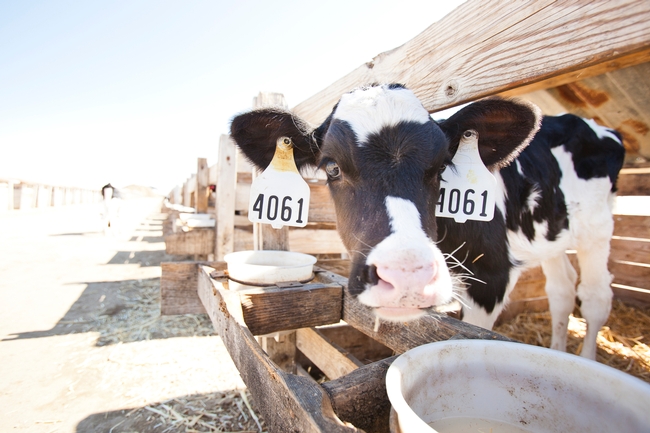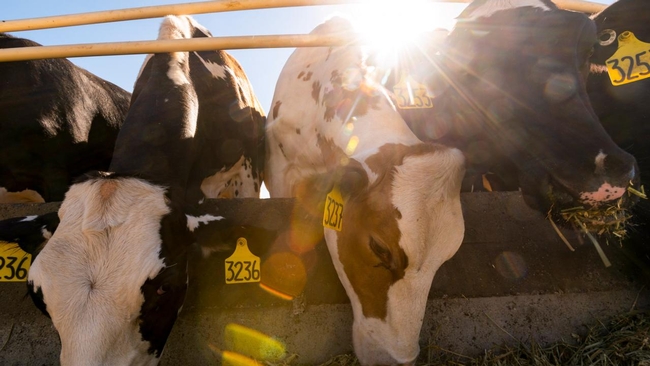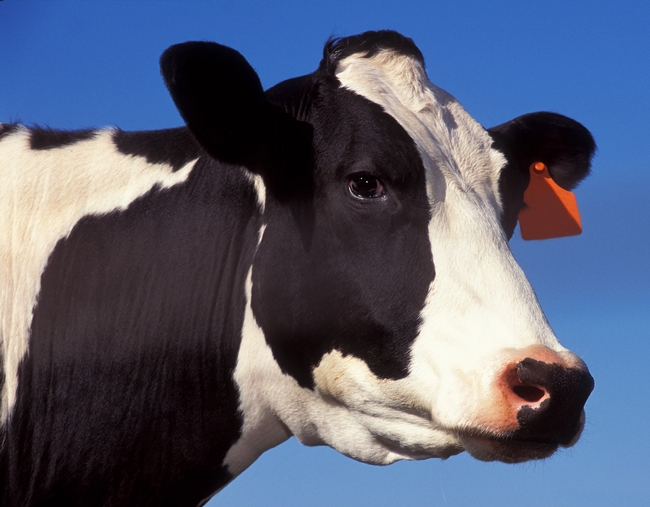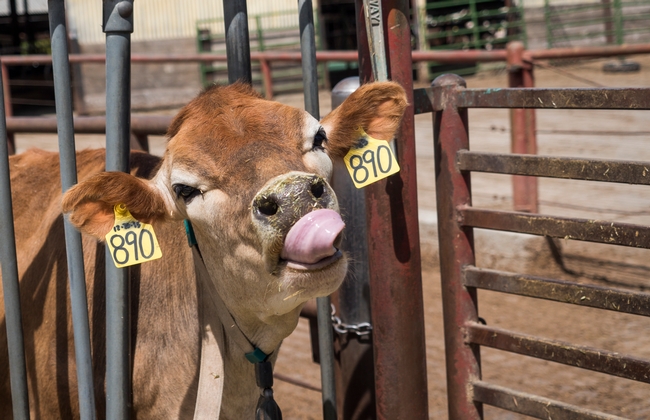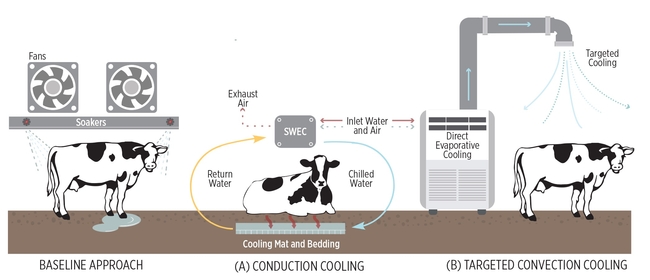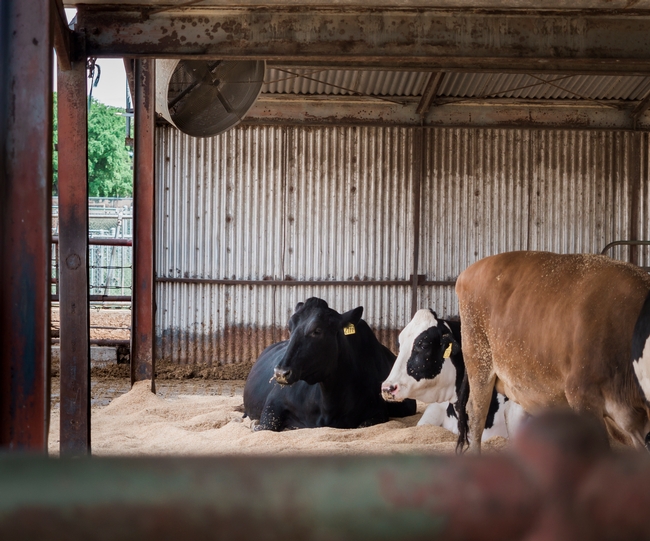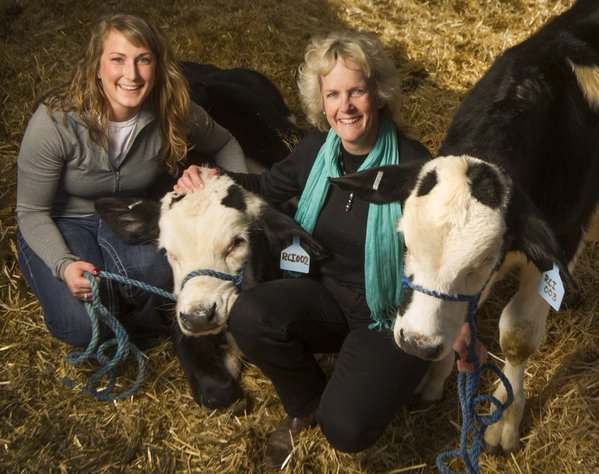Posts Tagged: dairy
Report: California on path to significant dairy methane reduction
Researchers say dairy farms on track to achieve full 40% reduction goal by 2030
The California Dairy Research Foundation and University of California, Davis CLEAR Center announced on Dec. 14 the release of a new analysis of methane reduction progress titled "Meeting the Call: How California is Pioneering a Pathway to Significant Dairy Sector Methane Reduction." The paper, authored by researchers at UC Davis affiliated with UC Agriculture and Natural Resources, concludes that efforts are on track to achieve the state's world-leading target for reducing dairy methane emissions by 40% by 2030.
The report, written by distinguished professors of livestock emissions and agricultural economics, takes a comprehensive look at progress and projections, expanding upon the analysis of progress previously conducted by the California Air Resources Board. By documenting achievements to date, additional reduction efforts already funded, historic and current economic trends, and the projected availability of new solutions, the analysis lays out a workable path toward meeting California's goal. The pathway shows that California dairy farms are on track to achieve the full 40% dairy methane reduction goal and will reach “climate neutrality” by 2030. Climate neutrality is the point in which no additional warming is added to the atmosphere.
“This analysis shows that California's dairy sector is well on its way to achieving the target that was established by SB 1383 in 2016,” said CDRF's Executive Director Denise Mullinax. “With much important work still ahead, a clear understanding of this pathway helps dairy farmers, policy makers, researchers, and other partners make decisions to strategically press forward.”
The report outlines the need for continued implementation of California's four-part strategy for dairy methane reduction: farm efficiency and herd attrition, methane avoidance (alternative manure management), methane capture and utilization (digesters), and enteric methane reduction. Continued alignment of state and federal climate-smart agricultural approaches and incentives will also be critical to maintaining progress.
"Milk demand is growing, and California is among the world's low-cost suppliers of dairy products. It follows that effective California policy to reduce dairy greenhouse gas emissions must recognize that measures that cause milk production to exit the state do not mitigate global climate change," said study co-author Daniel Sumner, Distinguished Professor in the Department of Agriculture and Resource Economics at UC Davis. "Therefore, measures to help off-set mitigation costs, provide positive incentives for adoption of low-cost emission-reducing practices, and help stimulate innovation in methane reduction, are the economically efficient approaches."
The paper recognizes that enteric methane from the dairy and other livestock sectors is a significant source of greenhouse gas emissions in the U.S. and California. Several feed additives are expected to become commercially available in the next several years, which could be used to reduce enteric methane emissions from California's dairy herd.
“Adoption of enteric feed additives will become a valuable tool for dairy value chains to meet their greenhouse gas reduction goals,” said co-author and professor Ermias Kebreab, associate dean of global engagement and director of the World Food Center at UC Davis. “While this report provides only a broad overview of some of the most promising solutions, there is an incredible amount of research being conducted at UC Davis, nationally and internationally. The dairy industry, global food companies, state and federal agencies, and others continue to invest heavily in supporting enteric mitigation research efforts.”
The report finds that methane reductions from California's programs and projects in place today, coupled with the implementation of a moderate feed additive strategy to reduce enteric emissions, is on track to reduce between 7.61 to 10.59 million metric tons of methane (CO2e) by 2030, all from the dairy sector alone.
The collective investment in California's dairy methane reduction effort — from public and private funding — now exceeds $2 billion and counting. The California dairy sector, in coordination with the California Department of Food and Agriculture, was recently awarded up to $85 million by the United States Department of Agriculture under the Partnerships for Climate-Smart Commodities. The funding will leverage additional matching state funds and private capital investments, for a total of more than $300 million in new investment.
“It is important to highlight California's investments and success to date as an example of what is possible within the global livestock sector,” said co-author Frank Mitloehner, UC Davis animal science professor and air quality specialist in Cooperative Extension, and director of the UC Davis CLEAR Center. “California dairy farmers have demonstrated tremendous progress toward the state's methane reduction goal over the past several years. Given the short-lived nature of methane, this rapid reduction is an important contribution to the global effort to quickly limit climate warming.”
The author's analysis was prepared by Gladstein Neandross & Associates (GNA). Funding was provided by CDRF as part of its work to support an innovative and sustainable California dairy industry.
UC helps California dairy farmers experiment with milking robots
The technological developments were critical to the formation of California's enormous dairy industry, the largest in the nation. Today, more than 1.7 million cows produce 39.8 billion pounds of milk in California each year, according to the California Milk Advisory Board.
The march of progress continues. The state's dairy industry is now beginning to integrate robots and sophisticated computer software into cow barns to maintain the supply of wholesome and inexpensive dairy foods for Americans. UC Cooperative Extension scientists are poised to help them adapt to the new technologies.
On most California dairies, cows are led two or three times each day from the barn to the milking parlor by workers. They clean the cows' udders to remove bacteria and surface dirt, evaluate whether the cow has mastitis, attach the milking machines, and disinfect the cow's teats after milking before taking the cows back to their pens.
“Dairy production is automated, but it is still a very labor intensive activity,” said Fernanda Ferreira, UC Cooperative Extension dairy specialist based at the UC Veterinary Medicine Teaching and Research Center in Tulare. “Farmers always tell us that the most challenging thing they are facing is labor – labor availability, training and cost.”
Milking robots – a technology already being used in dairies in the Midwest and Eastern U.S., Europe, South America and Canada – promises greater automation, reduced labor needs and improved animal welfare.
View a short video clip of the milking robot in action.
The machines don't resemble a stereotypical robot character, but rather are computerized boxes large enough to fit one cow, with a robot arm programmed to reach under the cow and clamp onto the teats. Cows do not need to be led to the milking machine, but rather walk into the box voluntarily when they are ready to be milked.
The machine recognizes each individual cow by a computer tag around her neck or on the ear, and provides personalized milking service. The robots do all the work: clean the teats, attach the milking machines, and disinfect the teats after the milking is done. While milking, the robot collects data on the cow's output and health.
When it comes to California and all the West, these are very new,” Ferreira said. “We're talking herds that have 1,800 cows on average. Huge herds. Since each of the robotic units, which serve 60 to 70 cows, costs about $120,000, we're also talking about a huge investment.”
Two San Joaquin Valley dairies have already installed milking robots, and many others are interested in the new technology. Ferreira and other researchers from the VMTRC in Tulare are collaborating with one of them to study how the machine and the herd's management can be adapted to better serve large-scale dairy herds like those in California.
“Our idea is to first understand the perspective of the producers who have cows being milked by robots. We want to know what they have learned so far, the challenges they have encountered, their relationship with banks,” Ferreira said. “Relationships with banks are important because most dairies will need to borrow funds to equip their facilities with enough robots for full automation.”
Future research will review issues of milk quality, mastitis management and determine what data farmers will need from the computerized system to improve dairy profitability.
“There are a lot of options available from companies that manufacture the robots. We want to fully understand how they work for our farmers and cows to be able to inform the future of California's dairy industry,” Ferreira said.
November News Clips (11/15-11/30)
How they survived: Owners of the few homes left standing around Paradise, Calif., took critical steps to ward off wildfires
(Washington Post) Sarah Kaplan, Frances Stead Sellers, Nov. 30
…Though the United States spends upwards of $2 billion each year on fire suppression and billions more helping communities recover, the current budget for the Federal Emergency Management Agency's Pre-Disaster Mitigation Grant Program is just over $200 million — and it must address hurricanes, earthquakes and a host of other natural hazards as well as fires. Cal Fire provides grants for forest management and tree removal, but not structure modification.
The budget for the University of California Cooperative Extension program, which conducts fire research and outreach to homeowners, has been cut by almost half since 2000. There are now fewer than 20 extension advisers in forestry and fire serving a state with 40 million people and 15 million acres of public lands.
Opinion | To Help Prevent the Next Big Wildfire, Let the Forest Burn
(NY Times) Ash Ngu and Sahil Chinoy, Nov. 29
Before Euro-American settlement in the 1800s, fires burned about 1.5 million acres of forest each year, on average, according to an analysis of fire return intervals by Scott Stephens, a professor of fire science at the University of California, Berkeley. Skies were most likely smoky through much of the summer and fall, and most forests in California burned every five to 25 years from wildfires caused by lightning or Native American burning practices, he said.
Farmers make a “Romaine Recovery” after E. coli Outbreak
(NBC PalmSprings) Daytona Everett, Nov. 28
The FDA has now connected the Central Coast of California to 43 cases of E. coli across the country. However, romaine lettuce farmers in the Coachella Valley are just now bringing in their first winter harvest.
...The FDA now requires every package to “clearly and prominently label all individually packaged romaine products to identify growing region and harvest date for romaine; and to clearly and prominently label at the point of sale the growing region when it is now possible for romaine lettuce suppliers to label the package (e.g. individual unwrapped whole heads of romaine lettuce available in retail stores).”
“That also gets difficult because they harvest the lettuce and they stick a bunch of these in a box and then they go to a processing facility and you may be combining several different fields at once when you're processing that,” Milt Mcgiffen, an extension vegetable specialist from UC Riverside, said.
https://nbcpalmsprings.com/2018/11/28/farmers-make-a-romaine-recovery-after-e-coli-outbreak
Wildfire, Landscapes and Debris Fields: Mapping Risks After Major Wildfire
(Capital Public Radio) Beth Duncan, Nov. 27
Geologist spend a lot of time creating landslide risk maps after a major wildfire happens. The slope of the landscape, amount of rainfall and underlying geology of an area all play a role in how likely an area might be affected.
Forestry Specialist William Stewart explains what geologists are concerned about as winter storms move through the areas hit by wildfire this year.
“After the wildfire, there's a lot of burnt logs and other things there, but what happens when it starts raining is it'll saturate the soil and you'll start to get soil movement. And once you get a fair bit of it moving down, it can pick up boulders and other things in the soil, and pull down whole trees. So a debris flow has both mud and water and big chunks of rocks and logs in there and that's what if it hits a bridge or a home, or commercial center, can just wipe it out. It's just a huge amount of force that just levels everything in its path.”
California Economic Summit Looks to Elevate Rural California
(AgNetWest) Brian German, Nov. 27
…“One of the things we really started digging into these last few years there, as part of our Working Landscapes Action Team and the summit as a whole, is this concept of there's two California's here,” said Vice President of UC Agriculture and Natural Resources, Glenda Humiston. “You've got predominately coastal, large, urban areas here that are doing pretty well. But then you've got the rest of California that's still really hurting. High poverty, high unemployment, not the economic opportunities that they ought to have.”
Humiston explained that at last year's summit they were able to launch the Elevate Rural California initiative, with a goal of addressing three specific areas over the next few years. “Water infrastructure, biomass, high-value biomass opportunities I want to qualify that strongly, and then the broadband, particularly rural broadband,” Humiston noted.
http://agnetwest.com/california-economic-summit-rural/
Why There Are Challenges To Doing More Prescribed Burns As Part Of Forest Management
(NPR All Things Considered) Ezra David Romero, Nov. 27
…But can the use of prescribed burns be expanded?
Roger Bales with the Sierra Nevada Research Institute at UC Merced says yes. “They can be scaled up as long as we can provide the financing to do them,” Bales said. “As long as we do them in a way that doesn't degrade the air quality.”
…The cost of a prescribed burn varies depending on time of year and resources. Robert York with UC Berkeley's Blodgett Forest Research Station says the warmer and drier the climate, the more expensive a burn.
Still, York supports burning year-round. “If the conditions are good, let's have lots of burns going on in the Sierra Nevada,” he said.
Field Scouting Guide: Palmer Amaranth
(Growing Produce) Karli Petrovic, Nov. 27
This month's field scouting guide concentrates on Amaranthus palmeri S. Watson (Palmer amaranth). We've reached out to weed scientists to learn how to spot and treat this weed.
Our contributors are Lynn Brandenberger, Oklahoma State University; W. Carroll Johnson, III, Ph.D., USDA-ARS; Mohsen B. Mesgaran, Ph.D., University of California, Davis; and Lynn M. Sosnoskie, Ph.D., University of California Cooperative Extension.
https://www.growingproduce.com/vegetables/field-scouting-guide-palmer-amaranth
Who is Responsible for Burned Trees After a Wildfire?
(NPR Morning Edition) Eric Whitney, Nov. 26
…SCOTT STEPHENS: I would be very nervous about big oaks and potential for them to come down because the oaks, a lot of times, have heart rot. They have rotten material inside the center. And a lot of times a smoldering fire can burn in there for days and days and days. I've been around oaks like that. And all of a sudden, a week later - boom - it comes down.
WHITNEY: The danger can persist a lot longer than a week, Stephens says, as burned trees that are strong now continue to deteriorate.
STEPHENS: Probably by year four, five, they start to really get less structurally sound. Then, of course, you get a wind event, big storms, and they start coming down in earnest. And by year 10, they're coming down a great deal.
https://www.npr.org/2018/11/26/670752900/who-is-responsible-for-burned-trees-after-a-wildfire
California dairy program celebrates 20 years
DairyBusiness, Nov. 26
…Recognizing a need to respond and be proactive, a committee of dairy producers, government agency representatives, industry leaders, and university specialists gathered to create the California Dairy Quality Assurance Program (CDQAP), ensuring high-quality milk production and continuous improvement in environmental stewardship. It was also a prime opportunity to demonstrate the commitment of the California dairy industry to producing high quality, safe products, in an environmentally friendly, animal-care conscience manner. Initial funding was provided by the California Farm Bureau Federation, California Department of Food and Agriculture and the California Dairy Research Foundation (CDRF). Dr. Michael Payne, a University of California veterinary researcher was brought on board to direct the program and Dr. Deanne Meyer, University of California Cooperative Extension specialist, was enlisted to develop educational programs. Continued CDRF funding provided an important direct tie to dairy producers through check off dollars, and industry expertise.
https://www.dairybusiness.com/california-dairy-program-celebrates-20-years/
Are Your Vineyards Smart Enough to Beat the Heat?
(Growing Produce) Matthew Fidelibus, Nov. 24
…A number of strategies can be considered to adapt to increasing temperatures. Small increases in temperature might be mitigated by employing various cultural practices including pruning, irrigation and fertilization, canopy management, and crop protectants, which may help reduce fruit exposure and reduce crop load.
Irrigation and fertilization can be used to help establish sufficient canopy shade before heat waves occur. The possibility of having overexposed fruit during heat waves should be considered when evaluating canopy management practices such as leafing and shoot positioning. Crop protectants such as particle films may provide protection for overexposed fruit.
https://www.growingproduce.com/fruits/grapes/are-your-vineyards-smart-enough-to-beat-the-heat
Fighting fire with fire via ‘pyrosilviculture'
(Davis Enterprise) Jeannette Warnert, Nov. 21
…The event also raised awareness of “pyrosilviculture,” a new forest management term coined by UC fire scientist Rob York to emphasize the importance of fire in silviculture, the management of forests for wood.
https://www.davisenterprise.com/local-news/fighting-fire-with-fire-via-pyrosilviculture/
Fixing state's fire problem: Costly, complex, next to impossible
(SF Chronicle) Kurtis Alexander, Nov. 21
…Bill Stewart, a forestry specialist at UC Berkeley, said that technology has helped fire scientists pinpoint areas where wind, heat, vegetation and other factors conspire to pose the greatest threats. It's just that the risk maps aren't being used to guide development.
“We need more than an academic paper here and there on wind,” Stewart said. “The number of windy days per year should help determine new zoning policy for planners.
Actually, Even California Says Trump Is Right About the Wildfires
(RealClear Politics) Betsy McCaughey, Nov. 21
President Donald Trump's critics are belittling him for not buying the politically correct narrative that global warming is to blame for the California wildfires. Instead, Trump correctly points to decades of mistakes by state and federal forest agencies that caused the woodlands to be become overly dense and blanketed with highly flammable dead wood and underbrush.
… This multifaceted approach is too much to put in a mere tweet. But University of California forest expert Yana Valachovic concedes that Trump's "general sentiment is correct."
Living on the Edge
(Slate Magazine) James B. Meigs, Nov. 20
…But the photos tell a different story. Within Paradise itself, the main fuel feeding the fire wasn't trees, nor the underbrush Trump suggested should have been raked up. It was buildings. The forest fire became an infrastructure fire. Fire researchers Faith Kearns and Max Moritz describe what can happen when a wildfire approaches a suburban neighborhood during the high-wind conditions common during the California fall: First, a “storm of burning embers” will shower the neighborhood, setting some structures on fire. “Under the worst circumstances, wind driven home-to-home fire spread then occurs, causing risky, fast-moving ‘urban conflagrations' that can be almost impossible to stop and extremely dangerous to evacuate.” The town of Paradise didn't just experience a fast-moving wildfire, its own layout, building designs, and city management turned that fire into something even scarier.
…Of course, when fires do occur, the residents of these areas suffer the most. The question is how to provide the right incentives for people so that we limit the chances of this happening again. Looking ahead, “We need to ensure that prospective homeowners can make informed decisions about the risks they face in the WUI,” Moritz, Tague, and Anderson say.
https://slate.com/technology/2018/11/camp-fire-disaster-causes-urban-wildland-interface.html
Why California Can't Chainsaw Its Way Out Of A Raging Inferno
(BuzzFeed) Peter Aldhous, Nov. 20
…Still, supporters of thinning argue that it is a viable option in some forests, especially dry pine and mixed-conifer forests at lower elevations. Historically, forests like these burned with low intensity every decade or so, keeping them patchy and fairly sparse. There, decades of fire suppression should be countered with careful thinning to mimic the natural state, according to Scott Stephens, a forestry scientist at the University of California, Berkeley.
Stephens has compared low-elevation forests in Southern California with those over the border in Baja California, Mexico, where fire suppression didn't begin until the 1970s. The naturally patchy Mexican forests, he has found, are much more resilient: Even in the face of a four-year drought and a 2003 wildfire, only 20% of the trees died. (In the Cedar fire in San Diego County that same year, between 40% and 95% of trees in the affected areas perished.)
https://www.buzzfeednews.com/article/peteraldhous/logging-forest-california-wildfires
California's Fire Season Extends Beyond Summer Months (AUDIO)
(NPR Morning Edition) Nov. 20
Steve Inskeep talks to Lenya Quinn-Davidson, fire adviser for the University of California Cooperative Extension, about what an extended fire season means for state residents.
https://www.npr.org/2018/11/20/669482111/californias-fire-season-extends-beyond-summer-months
Santa Maria-Bonita School Districts teams up with 4H for kids career day
(KEYT) Naja Hill, Nov. 18
Santa Maria-Bonita School Districts came together for a career and leadership day at Liberty Elementary. The event, called 4H SNAC, was a collaboration between UC CalFresh Nutrition and the youth organization 4 H. SNAC stands for Student Nutrition Advisory Council.
The goal of the youth program is to advocate child development to 5th and 6th graders in underserved, low-income communities. Various guest speakers came to teach kids how to live a healthy lifestyle.
The event was 4H's 4th annual career day. One topic of focus was presentation skills. The students also got an opportunity to speak to professionals from different fields such as firefighters, a nurse, and a dentist.
Trump suggests Californians can rake their forests to prevent wildfires. (He is wrong.)
(Washington Post) Avi Selk, Nov. 18
“His general sentiment is correct — that we need to manage fuels,” said Yana Valachovic a forest adviser with the University of California's Cooperative Extension program. “And yeah, managing that pine litter adjacent to our homes and buildings is super important. … But the reality is, to manage every little bit of fuel with a rake is not practical.”
Raking is an effective way to clear light debris like leaves and pine needles away from residences, she said. It's of much less use on the forest floor, where infernos burn through swaths of brush and large debris that only heavy machinery can clear.
California's problems are complicated, she said — a combination of hot, dry climates, poor community design and “100 years of fire suppression” that helped turn forests into tinder boxes.
How Trump administration pressure to dump 4-H's LGBT policy led to Iowa leader's firing
Courtney Crowder and Jason Clayworth, Des Moines Register, Nov. 18
Katherine Soule, the chair of an LGBT working group in 2016 and a leader of California's 4-H, said group leaders were asked to adapt the Obama administration's Dear Colleague letter protecting gender-identity rights for 4-H.
Soules and a group of Western 4-H leaders created a best-practices document that became the foundation of a national guidance document.
...The about-face on the LGTB policy by national 4-H headquarters left some 4-H volunteers angry and program officials confused, according to the Register's investigation.
“I feel bad for the folks at USDA,” Glenda Humiston, the vice president of the University of California's Agriculture and Natural Resources, told other 4-H leaders during a May training video. “I think they are in between a rock and a hard place.”
Lessons from Camp Fire: Staying alive in California fire country
(Mercury News) Lisa Krieger, Nov. 17
Even as smoke chokes the sky and shrouds the sun, millions of Bay Area and other California residents remain unprepared for the next inferno.
…“You can only pour so many cars into different arteries at the same time,” said J. Keith Gilless, professor and dean emeritus at UC Berkeley's College of Natural Resources.
…“Fewer than half of families in our area have taken the time to sit down, write out an emergency plan, discuss it with family members and maybe even do a practice run,” said UC Berkeley's Gilless.
https://www.mercurynews.com/2018/11/17/lessons-from-paradise-staying-alive-in-fire-country
Facts Matter: President's posts on wildfires misleading
(Chicago Daily Herald) Bob Oswald, Nov. 17
The current wildfires aren't forest fires and are not the responsibility of forest management, the Times said.
"These fires aren't even in forests," Max Moritz, a wildfire specialist at the University of California, Santa Barbara, told the Times.
The Camp and Woolsey fires began where communities are close to undeveloped areas, the Times said. Fires in these locations are more deadly and costly because of the proximity to homes and towns.
https://www.dailyherald.com/news/20181117/facts-matter-presidents-posts-on-wildfires-misleading
Why didn't PG&E shut down power in advance of deadly Camp Fire? Here's the data.
(Mercury News) Matthias Gafni, Nov. 17
…Thomas Scott, who has written about fire management in California's wildland urban interface and works with the UC Division of Agriculture and Natural Resources, wonders if the decision to keep power on may have had to do with the complaints the utility received after its October shutdown.
“Any rationale they had for keeping the lines hot has tragically backfired for everyone involved,” he said. “Can't understand what they were contemplating; perhaps they maintained power until the last possible moment because that action breeds unhappy customers and dangerous situations if power is turned off.”
Examining Jerry Brown's veto of California wildfire legislation and the criticism of it
(Politifact) Chris Nichols, Nov. 16
Bill Stewart, a forestry specialist at UC Berkeley, reviewed the bill and Brown's veto message. He said in an email, "I do not think it would have made much of a difference, as the amount of funds was not that great ($582,000 that may have just led to some hiring of consultants and a lot interaction with the communities) and, more importantly, no new advances would have been made."
Stewart, however, went on to describe the legislation as "a good shot across the bow to the (Brown) administration to do more. This area of risk assessment and mitigation has been woefully underfunded for decades."
How fierce fall and winter winds help fuel California fires
(The Conversation) Faith Kearns and Max Moritz, Nov. 16
… Fire hazard is determined by a variety of factors that include vegetation, topography and weather. Add people and homes, and you get fire risk. While wind is one of the biggest factors in fire spread, it also generates flying embers far ahead of the fire itself.
… Managing the type and amount of vegetation, or “fuel,” in an area provides a set of tools for altering fire behavior in wildland fires. But during wind-driven urban conflagrations, homes are usually a major – if not the main – source of fuel.
…As residents and researchers who have worked extensively on fire in California, we believe the state and its newly elected leadership face a formidable challenge and an opportunity to reinvest in a robust, interdisciplinary approach to wildfire risk reduction that combines the best of both research and practice. It must integrate both new (and potentially controversial) urban planning reforms as well as novel thinking about evacuation alternatives.
https://theconversation.com/how-fierce-fall-and-winter-winds-help-fuel-california-fires-106985
California Citrus Network Now Available as Grower Resource
(AgNetWest) Nov. 16
The University of California Cooperative Extension (UCCE) has launched the California Citrus Network as a means to address industry concerns through a collaborative approach. The new website will be another resource available to those involved with citrus production who may have questions or concerns about their operation.
“If they see something out in the field that's unusual, they can snap some pictures with their smartphone or their tablet and they can go onto the forum site,” said UCCE Area Citrus Advisor for Tulare, Fresno, and Madera Counties Greg Douhan. “Let's say you think something is some sort of disease issue, you can go in there and look on that and see if anybody else has been seeing the same thing. Or you can post a question and say, ‘hey I'm finding this unusual situation out in my field, is anybody else seeing this?' so it's just a way to communicate.”
http://agnetwest.com/california-citrus-network-now-available
Editorial: Horrifying infernos in California
(Providence RI Journal) Nov. 16
California deals with wildfires on an annual basis. Parts of the state were ravaged earlier this summer. But what has happened this month alone will make 2018 the worst year on record.
Five separate wildfires (named Camp, Nurse, Hill, Woolsey and Peak) in November have burned more than 245,000 acres of land.
…Max Moritz, a wildfire specialist with the University of California, told the AP that there are “so many ways that can go wrong, in the warning, the modes of getting the message out, the confusion ... the traffic jams.” He suggested local officials consider building “local retreat zones” and “local safety zones” in urban communities to protect residents from the deadly wildfires.
http://www.providencejournal.com/opinion/20181116/editorial-horrifying-infernos-in-california
See how a warmer world primed California for large fires
(National Geographic) Alejandra Borunda, Nov. 15
…Over the past century, California has warmed by about three degrees Fahrenheit. That extra-warmed air sucks water out of plants and soils, leaving the trees, shrubs, and rolling grasslands of the state dry and primed to burn.
That vegetation-drying effect compounds with every degree of warming, explains Daniel Swain, a climate scientist at the University of California, Los Angeles, meaning that plants lose their water more efficiently today than they did before climate change ratcheted up California's temperatures.
…Changes in precipitation are another factor. California's summer dry season has also been lengthening. Each extra day lets plants dry out more, increasing their susceptibility to burning.
“Usually—or, I don't want to even say usually anymore because things are changing so fast—we get some rains around Halloween that wet things down,” says Faith Kearns, a scientist at University of California Institute for Water Resources in Oakland. But in the past few years, those rains haven't come until much later in the autumn—November, or even December.
https://www.nationalgeographic.com/environment/2018/11/climate-change-california-wildfire
Why Wildfires Are Burning So Hot and Moving So Fast
(NPR) Kirk Siegler, Nov. 15
…One recent study predicted several million homes built in the West are at immediate risk. Susie Kocher is a forester with the University of California's Cooperative Extension service here in the Sierra.
“We haven't caught up, and to retrofit our existing housing stock to fend off embers is a long-term, expensive proposition.”
Keeping cows cool with less water and energy
Innovative cooling technologies tested on dairy cows at UC Davis are addressing the long-standing challenge of keeping dairy cows cool in heat-stressed California.
Standard livestock cooling methods, such as fans and sprinkling cows with water, require significant amounts of electricity and water. The new technologies, being tested at UC Davis by the Western Cooling Efficiency Center and the Department of Animal Science, are designed to reduce water by up to 86 percent and electricity by up to 38 percent over conventional methods.
Milk production and heat stress
Milk is the most valued agricultural commodity in California, with $9.4 billion in retail sales in 2014. Roughly one in every five dairy cows in the nation lives in California. In addition to disturbing the cow, heat stress is a major cause of diminished milk production in dairy cows, with annual losses directly related to heat stress exceeding $800 million.
“The process of rumination, where cows ferment their food, produces a lot of heat, as does milk production itself,” said Cassandra Tucker, a professor in the Department of Animal Science who focuses on dairy cattle welfare. “When the outside temperatures also rise, it's a challenge for the animal in how she's going to try to keep cool. This project is trying to reduce the energy and water use associated with that to help both the cows and the dairy producers.”
How it works
The technologies involve two approaches. The first is conduction cooling, where the bedding area is cooled using heat exchange mats placed where cows lie down. To reduce energy consumption, water flowing through the mats is cooled through a novel evaporative chiller called a Sub-Wet Bulb Evaporative Chiller.
The second approach is targeted convection cooling, which uses fabric ducting to direct cool air onto the cows while they lie down and when they eat. The air is cooled using a high-efficiency direct evaporative cooler.
"This is an exciting research opportunity for UC Davis to combine our expertise in engineering with our expertise in animal science,” said Theresa Pistochini, senior engineer at the Western Cooling Efficiency Center. “There is significant potential to apply existing technologies in a novel way to reduce both energy and water used to cool dairy cows. Through this project we aim to design, test and demonstrate an efficient alternative.”
The project is part of a four-year, $1 million grant from the California Energy Commission to help improve water and energy efficiency in California's dairy industry. The data being collected now will help determine which technology the team should use to pilot at a commercial dairy in a future phase of the project.
For more information, contact:
Kat Kerlin, UC Davis News and Media Relations, 530-752-7704, 530-750-9195 (cell), kekerlin@ucdavis.edu
Paul Fortunato, UC Davis Western Cooling Efficiency Center, 530-752-0280, 916-412-3022, pfortunato@ucdavis.edu
Scientists using genetic editing to delete dairy cow horns
Dairy cows have been bred for optimal dairy production, but the gene mix brought along horns. Angus beef were bred for optimal beef production, and don't have horns. Since the dairy industry doesn't want animals with horns because they can hurt each other or farmworkers, it is common practice to remove them shortly after birth.
Removing the horns involves an uncomfortable procedure called debudding, in which, after being treated with a local anesthetic, the cells on the animal's head that would grow into horns are killed with an electrical appliance.
"Consumers are concerned about how we care for dairy animals. They expect us to do a good job and are concerned about pain and discomfort," said UC Davis veterinarian Terry Lehenbauer in a video about the advancement (See the video below).
Using precision genetic "editing," scientists were able to delete the dairy cow gene that produced horns and replace it with the angus gene that resulted in hornlessness.
At UC Davis, the two calves' growth and development will be tracked. Eventually they will father cows with horned mothers to see if the hornless trait is passed on to the offspring. The odds of them doing so, Van Eenennaam said, are 100 percent, if "Mendelian genetics hold true." Mendelian genetics are laws of gene inheritance discovered by 19th century monk Johann Mendel.
Van Eenennaam said it's not clear whether other, unexpected effects of the gene editing will occur. However, if successful, gene editing will allow the dairy industry to bypass decades of breeding for hornless cows.


